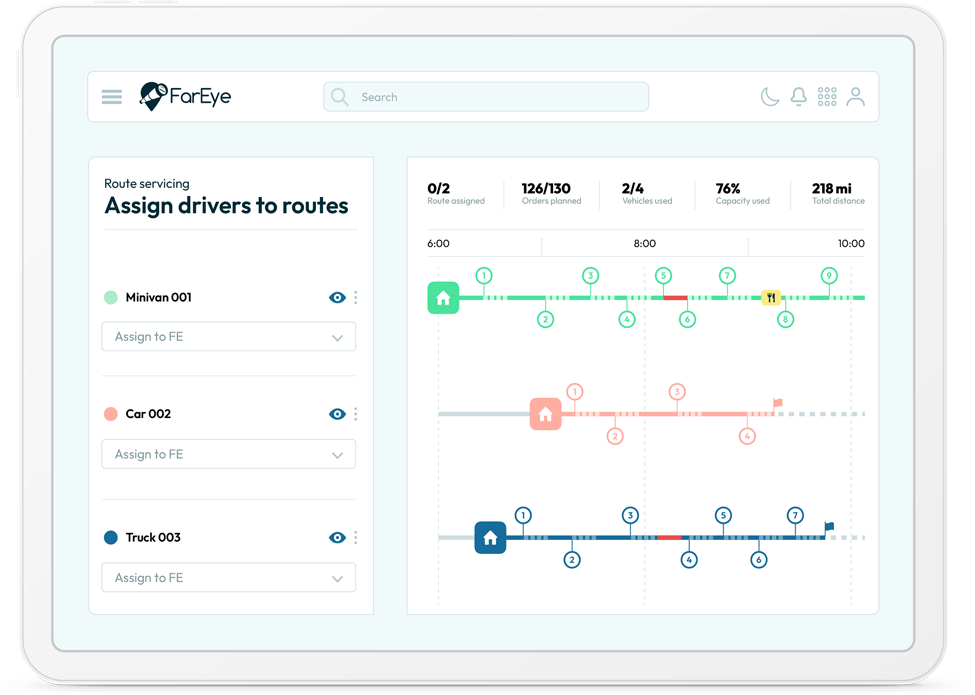- Parcel Delivery
Scalability Challenges and Solutions in Parcel Delivery Software Implementation
Table of Contents
- The Consumer Impact of Routing Breakdowns
- Why Scalability in Parcel Delivery Software is no Longer Optional
- Key Scalability Challenges in Parcel Delivery Optimization
- How FarEye’s AI-Powered Parcel Delivery Software Solves Scalability
- Best Practices for Scalable Implementation
- Setting a New Standard for Parcel Delivery at Scale
- FAQs

The everyday American expectation is simple: order a product online, be it a fridge, a pair of sneakers, or medication, and have it delivered on time, in perfect condition, with updates along the way. In 2025, that’s no longer a luxury but a baseline standard and much of it depends on parcel delivery software working behind the scenes.
The numbers say it all. According to a report, over 22.37 billion parcels are projected to be shipped to the United States. This figure has doubled in less than a decade.
Yet, behind every successful doorstep delivery lies an invisible web of routing decisions, allocation choices, and a software engine that must scale on demand. When the software falters, the consequences ripple through every link in the logistics chain, causing delays, reschedules, lost packages, and frustrated customers.

The Consumer Impact of Routing Breakdowns
Anyone who’s tracked a much-anticipated delivery, refreshed the status, waiting for a text-only to receive a sudden reschedule knows the sting. For enterprises and couriers, these customer moments are the outcome of decisions made at scale.
Hundreds of thousands of daily deliveries, each shaped by order volume, vehicle capacity, traffic, weather, and sudden ad-hoc changes. When parcel delivery software fails to scale, even the best planning is quickly undone, leading to missed SLAs, overtime costs, and negative reviews.
Behind the scenes, the challenge is simple in theory but staggering in practice: how do you ensure every fridge, shoe box, and prescription finds its way to the right door at the promised time across sprawling geographies and ever-shifting traffic patterns? That’s where the story of scalable parcel delivery software and advanced parcel delivery optimization really begins.
Why Scalability in Parcel Delivery Software is no Longer Optional
For most enterprises, delivery volumes aren’t just high; they’re unpredictable. Sales can double overnight during peak events or promotions. Same-day and next-day delivery promises have tightened planning windows and raised customer expectations. Manual allocation, paper-based processes, or legacy tools simply can’t keep up.
Scalability in parcel delivery software means more than handling more orders. It’s about keeping costs down, performance steady, and service transparent, whether managing 500 orders or 50,000 in a day.
The difference between scalable and non-scalable platforms becomes clear every time a surge hits: delays stack up, drivers wait in loading bays, routes overlap, and dispatchers scramble to patch gaps.
Key Scalability Challenges in Parcel Delivery Optimization
Scaling parcel delivery optimization presents a series of real-world hurdles that impact both customer experience and the bottom line. Each stage of route planning, dispatch, and execution brings its own technical and operational complexity.
- Massive Data Volumes and Real-Time Demands
Every new order adds complexity: addresses, delivery windows, parcel types, special instructions, and constraints like vehicle type or driver schedules. Multiply this by thousands of daily deliveries, and the system must process an astronomical number of routing permutations in real time. Batch-based legacy tools often fail under this load, causing allocation delays and operational bottlenecks. - Multi-Constraint Route Planning
Modern parcel routing isn’t just about finding the shortest path. It involves over a hundred constraints, from real-time traffic to vehicle capacity, driver shifts, controlled substances, EV charging stops, weather impacts, and delivery sequence. Traditional platforms struggle to incorporate so many variables dynamically, especially during surges or route changes. - Integration with Warehouse and Last-Mile Systems
Parcel delivery software rarely works in isolation. Integrations with order management, inventory, warehouse systems, and carrier networks are essential for end-to-end visibility and control. When volumes spike, these integrations must be robust enough to sync thousands of data points instantly. Even a brief lag can cascade into missed pickups and delayed deliveries. - Ad-Hoc and Same-Day Order Handling
The US consumer’s appetite for instant gratification, same-day, and ad-hoc orders is only growing. Traditional route planning can’t absorb these new orders without disrupting the entire delivery sequence. If the system can’t dynamically re-optimize routes in seconds, efficiency suffers, and so does customer satisfaction. - Resource and Driver Utilization
Scaling is about more than just software horsepower. It’s about maximizing stops per hour, balancing workloads across shifts, managing EV charging, and minimizing distance traveled. Manual processes or rigid allocation rules often lead to suboptimal utilization and unnecessary costs. - User Experience for Dispatchers
When delivery volumes balloon, so does the pressure on dispatchers. Clunky interfaces, manual steps, or unclear alerts can slow them down at the worst possible time. Dispatchers need systems that streamline bulk order assignment, real-time updates, and exception management; otherwise, human error and burnout become real risks. - Compliance, Security, and Transparency
As operations expand, so do regulatory requirements: e-signatures for delivery, controlled substance handling, temperature tracking, and cross-state compliance. Scalable parcel delivery software must adapt to these variables, offering built-in controls, audit trails, and secure data management without slowing down routing or adding friction for users.
How FarEye’s AI-Powered Parcel Delivery Software Solves Scalability
Addressing these challenges requires a new generation of parcel delivery optimization platforms that leverage AI, machine learning, and cloud-native design to deliver speed, flexibility, and reliability at any scale.
- AI and Machine Learning: The Heart of Scalable Routing
FarEye is leading the charge, applying ML-powered auto-routing to manage vast, dynamic delivery networks. By ingesting millions of data points, traffic feeds, driver location, parcel weight, and customer preferences, these algorithms generate optimized routes in minutes, not hours. For example, FarEye’s platform can process up to 4,000 orders in under 8 minutes, delivering up to 40% fewer delivery routes through pre-planning while managing 100+ real-world constraints.
Dynamic learning is key: as new data flows in (ad-hoc orders, weather changes, real-time traffic), AI models adapt routes instantly, ensuring drivers stay efficient and customers receive precise ETAs. Over time, these systems improve themselves by predicting bottlenecks, automating exception handling, and continuously refining allocation rules. - Multi-Constraint Optimization: More Than Just Distance
Scalable solutions must address every relevant parameter. FarEye’s parcel routing manages order, vehicle, road, and driver parameters in a single workflow. From handling controlled substances and special equipment needs to balancing EV charging, shift breaks, and cost variables, the software juggles complex scenarios without manual intervention. - Real-Time, Event-Driven Processing
Gone are the days of overnight route planning. Today, cloud-based parcel delivery software can ingest and process thousands of orders, dynamically re-optimizing as changes occur. Event-driven models ensure that every new pickup, cancellation, or route blockage is factored in immediately, keeping operations resilient, even during peak surges. - Seamless Integration Across the Delivery Chain
FarEye’s API-rich platform is designed to integrate with warehouse management, inventory, order systems, and carrier networks, syncing data in real time. This enables live visibility, automated notifications, and complete traceability from order intake to final proof of delivery. - User-Centric Design for Dispatchers and Drivers
High-volume operations depend on intuitive dashboards, visual route planners, and automated bulk assignment features. FarEye empowers dispatchers to process bulk orders, manage ad-hoc changes, and monitor progress from a single, easy-to-navigate interface. This reduces planning time from hours to minutes, freeing teams to focus on customer service and exceptions. - Cost Optimization at Scale
By maximizing stops per hour, reducing idle miles, and optimizing resource allocation, AI-based parcel delivery software lowers operational costs, even as volumes climb. With advanced analytics and real-time dashboards, logistics leaders can track KPIs, compare scenarios, and uncover new opportunities for efficiency and savings. - Built-In Compliance and Security
Scalable parcel delivery software must handle compliance needs natively, from digital proof of delivery to secure audit trails, real-time data encryption, and automated reporting. FarEye’s compliance modules ensure that businesses can expand to new markets and manage sensitive deliveries without fear of regulatory setbacks.
Implementation & ROI: Typical pilot to regional rollout: 4–8 weeks. Expected outcomes: 5–20% reduction in cost per delivery, 10–20% improvement in first-attempt delivery, and measurable throughput gains within 60–90 days.
Best Practices for Scalable Implementation
Implementing scalable parcel delivery software is not a plug-and-play exercise. It requires a methodical approach informed by industry best practices:
- Pilot Programs
Test the solution in a controlled environment, gradually expanding as performance stabilizes. - Load Testing
Simulate peak volumes to ensure routing algorithms and integrations remain robust under pressure. - Continuous Training
Equip dispatchers and field staff with hands-on, scenario-based training for smooth onboarding and daily use. - Ongoing Optimization
Leverage analytics to review KPIs and optimize both routing rules and operational workflows over time. - Stakeholder Alignment
Involve IT, operations, compliance, and customer service teams early to ensure seamless integration and value realization.
Setting a New Standard for Parcel Delivery at Scale
The stakes for parcel delivery in the US are higher than ever. Customers expect more, businesses face relentless competition, and volumes continue to climb. Scalable parcel delivery software driven by AI, machine learning, and real-time optimization is the new backbone of efficient, reliable delivery networks.
Enterprises seeking to avoid missed deliveries, reduce costs, and protect customer satisfaction must invest in platforms that adapt, learn, and deliver no matter the challenge or scale. FarEye has proven that intelligent, flexible, and user-friendly software is not just a future aspiration; it’s a necessity for today’s most demanding logistics environments.
Ready to scale parcel delivery without breaking operations? Request a demo to see how FarEye’s parcel delivery software improves routing, capacity, and cost control.
FAQs
- What most often causes scalability failures in parcel delivery software?
Lack of real-time processing, brittle integrations, limited constraint handling, and systems that don’t auto-scale under peak loads. - How fast can a modern platform scale during peak events?
Cloud-native, event-driven platforms can re-optimize in seconds and scale compute on demand; pilot-to-regional rollouts are commonly 4–8 weeks.
Source:

Komal Puri is a seasoned professional in the logistics and supply chain industry. As the AVP of Marketing and a subject matter expert at FarEye, she has been instrumental in shaping the industry narrative for the past decade. Her expertise and insights have earned her numerous awards and recognition. Komal’s writings reflect her deep understanding of the industry, offering valuable insights and thought leadership.
Let's Talk to Our Experts and Optimize Your Deliveries Today!
An expert from our team will reach out within 24 hours

